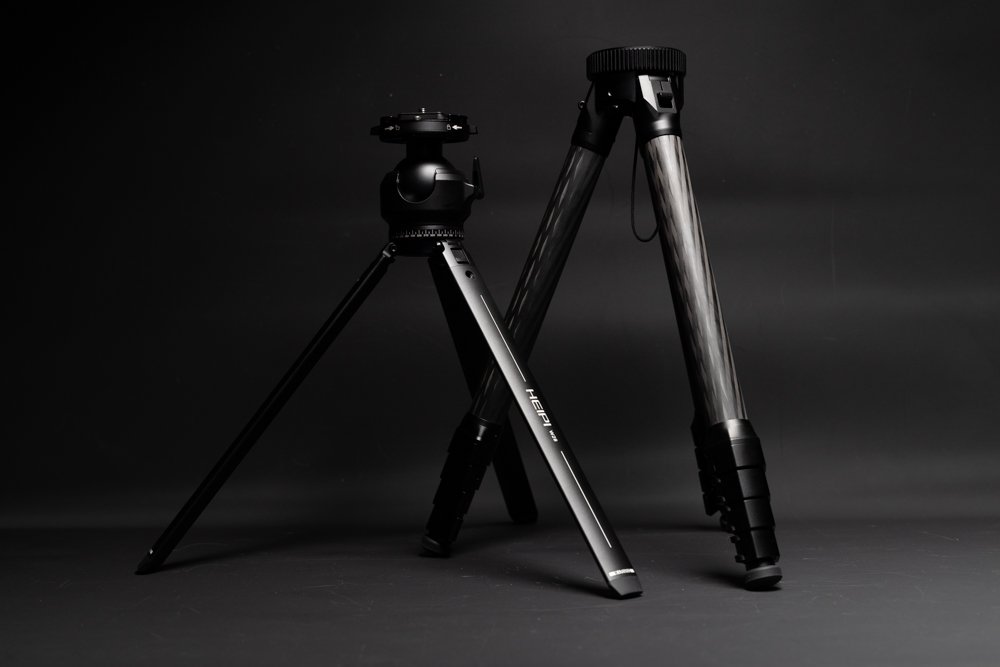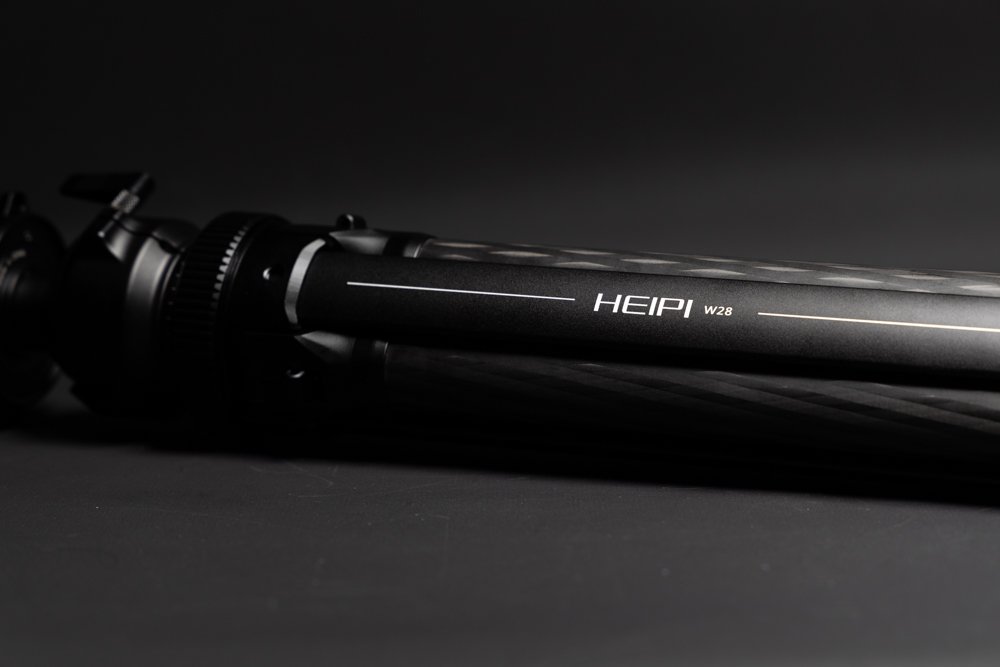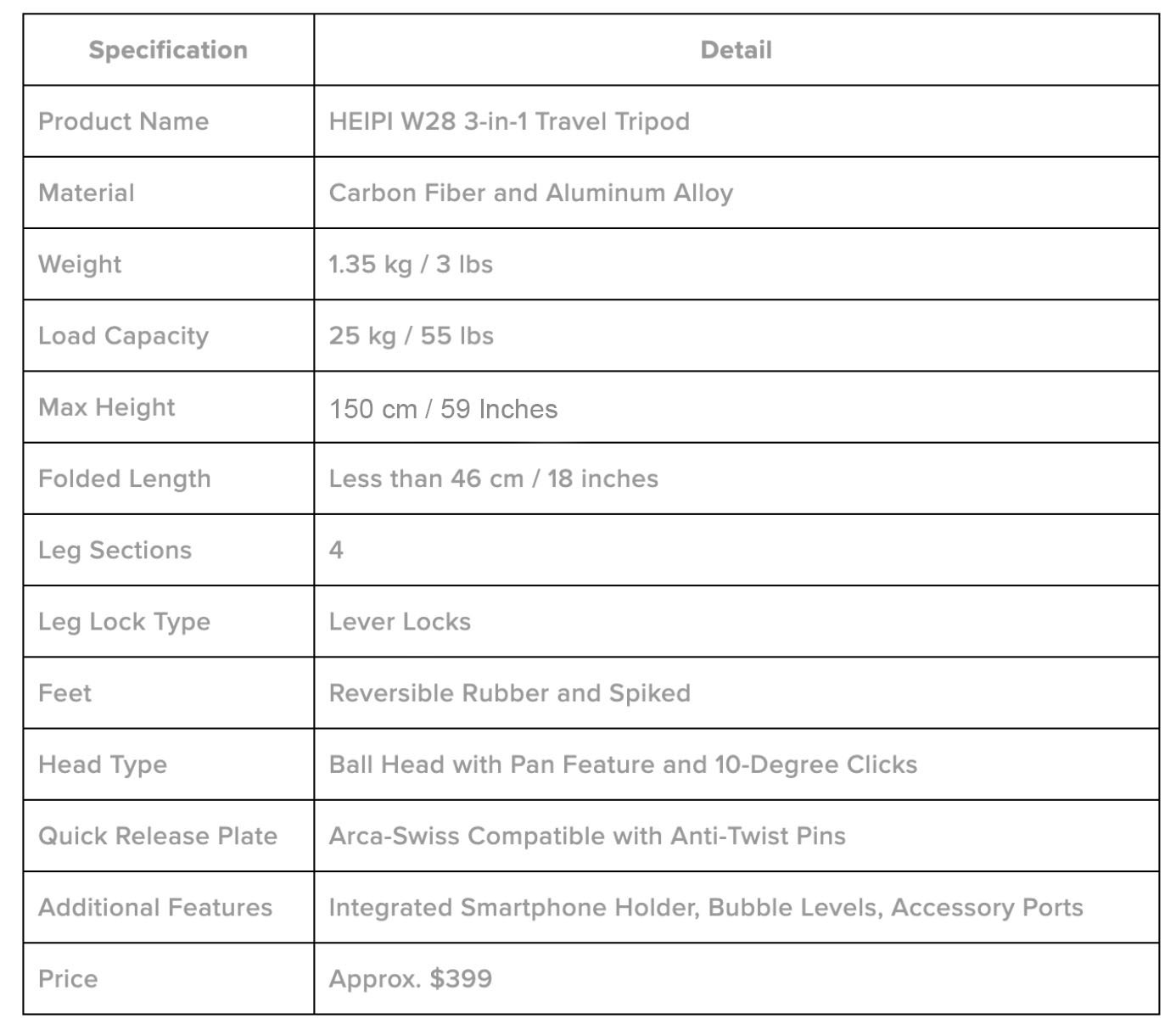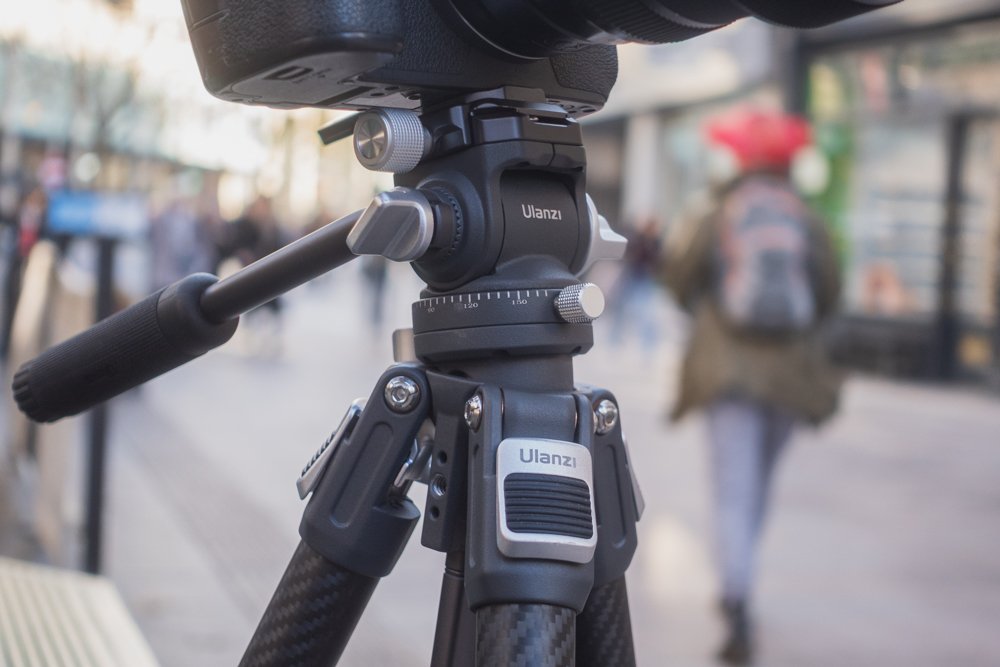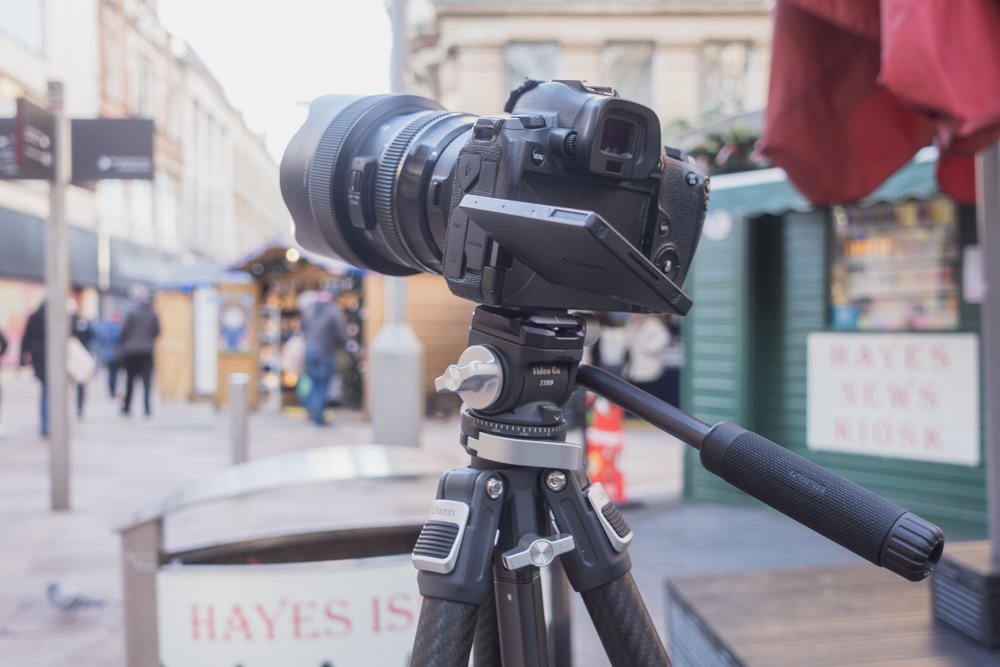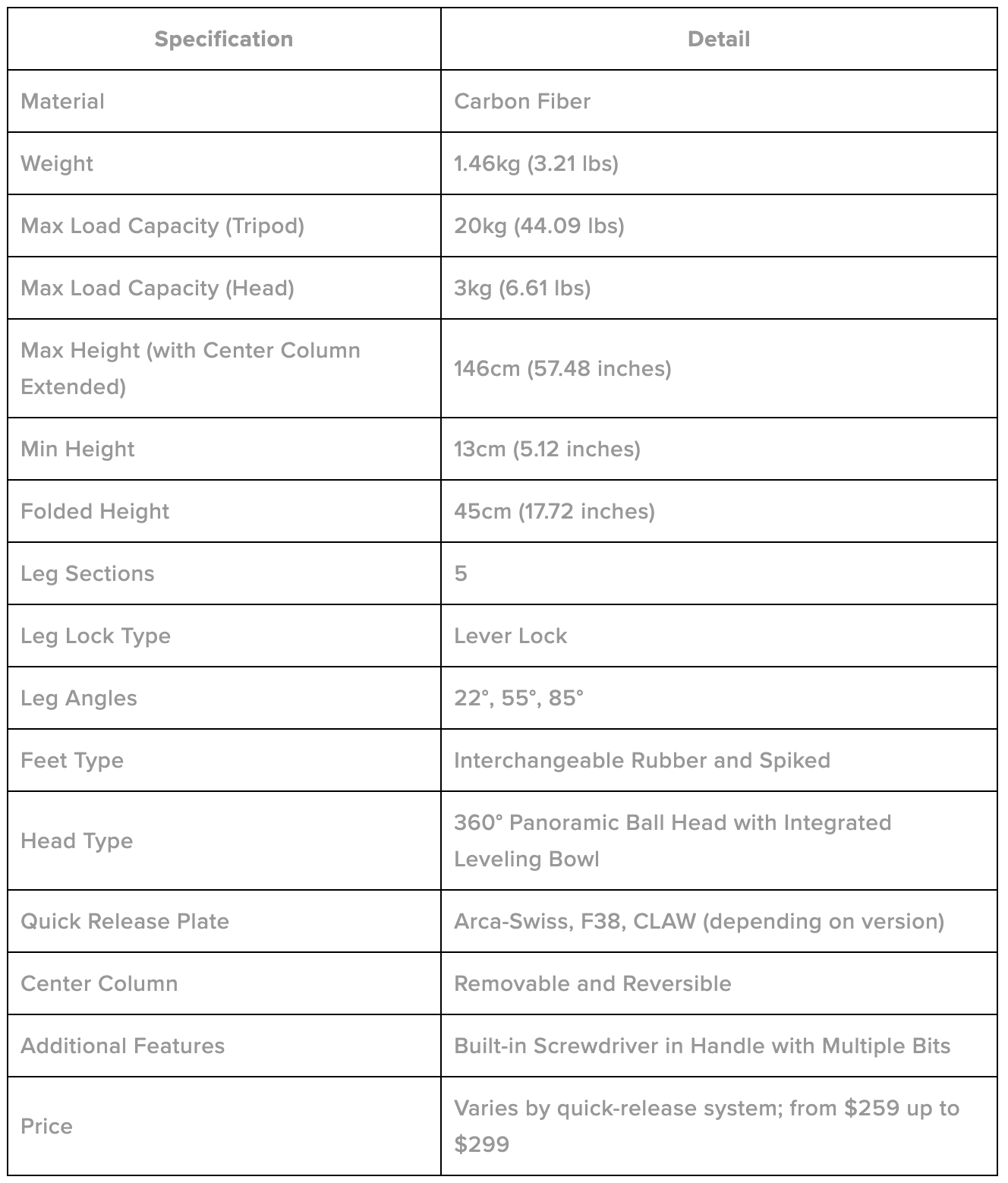REVIEW: HEIPI W28 3-in-1 Travel Tripod
The HEIPI W28 3-in-1 travel tripod is a robust, versatile choice for photographers, featuring a 25kg load capacity, an integrated smartphone holder, and a unique sub-tripod design. Ideal for professional and amateur use, it combines stability with convenience. Despite its hefty weight and adjustment complexity, the HEIPI W28 offers exceptional value and functionality for aspiring photogs.
A solid, reliable, and versatile tripod will make a world of difference for amateur and professional photographers who have relied for way too long on cheap, flimsy, and typically clunky budget options. While good tripods don't often come cheap (usually a few hundred bucks, at least), it's unusual to ever regret that choice. But, for those seeking maximal value for money, HEIPI's 3-in-1 travel tripod might be a pretty good bet.
It's a truly multi-functional companion for photographers and videographers alike, featuring an awesome amount of durability, flexibility, and a unique integrated design. Plus, it's really great to see, for once, that a Kickstarter project actually delivered in time, and something good came out at the other end. The goal is simple - to be a robust, all-in-one tripod solution for on-the-move shooting scenarios and mobility.
PLEASE NOTE: I WAS SENT THIS ITEM FOR REVIEW BUT NO OTHER PAYMENT OR CONTROL WAS EXCHANGED FOR PUBLISHING THIS UNBIASED REVIEW
Video Source - Dustin Abbott via YouTube
With that in mind, HEIPI has integrated a unique sub-tripod design, which doubles as a center column, or even as a standalone table-top tripod. Yet, despite its travel-focused form factor, the HEIPI W28 readily handles a 25kg (~55lbs) camera. Thus, ensuring stability for even professional-grade cameras. Although, for content creators and vloggers that shoot with phones, the ball head has a built-in smartphone holder.
Additionally, with thoughtful additions such as bubble levels, some spike feet, and accessory ports further help to enhance the HEIPI W28's functionality. Granted, it's not entirely perfect, as is evident by the W28's surprising heft that you have to lug around, and the need for hex wrenches to make adjustments. So, with that taken into consideration, should you look at the HEIPI W28 if you're shopping for a new tripod?
What Makes The HEIPI W28 Such A Compelling Package?
So, a bit more about that smartphone mount integration, which is quite unique when looking at other pro-grade camera tripods, it's conveniently located under the camera's mounting plate. This can support most smartphone sizes, so compatibility shouldn't be a problem. Plus, this feature is particularly handy for folks who switch between traditional cameras and smartphones, and this can be done rather speedily, too.
Videographers can benefit from the mounting system and ball head on the HEIPI W28, as well. HEIPI uses a ball head with an integrated pan head with 10-degree clicks, which is ideal for precise adjustments. This can be disabled, if you choose to, for smooth and consistent panning motions. What's more, there's a nice quick release plate with anti-twist pins, and compatibility with numerous popular camera models.
The leg locks and joints are another noteworthy highlight of the HEIPI W28 3-in-1 travel tripod. These are the brand's own, patented lever locks that are engineered for quick adjustments. In practice, I've found its operation to be pleasantly snappy and secure, providing confidence in the tripod's stability. I also like that the joints and the center column are pretty sturdy - not something you often find on budget tripods.
Thus, it allows for super smooth adjustments and a wide range of motion. You'll find that it ought to be a suitable tripod then, for various photography styles, such as macro or wildlife photography. The latter can be a tempting proposition, given that at just under 18 inches, the HEIPI W28 is compact enough that it's a superb tripod for traveling. Or, if you're regularly on the move, shifting around from shoot to shoot.
Where Does The HEIPI W28 Excel At?
Thus far, I've heaped praise for the HEIPI W28 travel tripod, and it's not without merit. So, here's a quick look at all the pros and upsides that HEIPI has built into the W28 that makes it such a brilliant tripod...
Dual Functionality - Being able to leverage the main and sub-tripods adds unmatched versatility. With this distinct design in mind, there are a few ways that you can use your tripod, whether you're crouched on the ground, in prone, or are mounting the tripod onto something secure. Aside from that, the HEIPI W28's sub-tripod is coupled neatly with the main tripods, ensuring that you can remove it within seconds. Better still, when it's tucked away, you won't even notice that it's there. This built-in, mini sub-tripod can offer a bit of extra shooting flexibility, particularly when you're vlogging or if a lighter setup is preferred.
Impressive Versatility - Weighing in at around 1.35kg (~3lbs), the HEIPI W28 is heavier than it appears, but this added mass does contribute a lot to its stability. Yet, it's compact enough when folded that it's handily travel-friendly. The load capacity, as I noted earlier, is quite impressive, allowing it to manage heavier gear with ease. I've seen folks use it with large format film cameras and vintage 120 cameras, with no problems whatsoever. On top of that, with a maximum height of 59 inches, the HEIPI W28 offers great reach. It's a good idea to be wary though, given that the minimum height is taller than some competitors, which might be a bit troublesome for storage.
Smooth Ball Head - The ball head on the HEIPI W28 is extremely smooth. Given that it's a tightly designed ball with pan head features, I reckon this will be highly appreciated by videographers on the go. Or, if and when you need to, the ball head itself is compatible with different plates for some extra convenience. You could further bet that it's an overall stable platform to lean and rely on, given the inclusion of a reversible spiked feet. There's a good level of stability on loose soil and sand, with those spiked feet providing a nice and secure grip on various terrains.
Video Source - Chris Schackart via YouTube
What Does The HEIPI W28 Do Poorly At?
Alas, it's not all sunshine and rainbows, since the HEIPI W28 does have its fair share of flaws that might be worth accounting for if you're considering adding it to your shopping cart...
Heavyweight Contender - While it might appear tiny at first glance, the HEIPI W28 has a good heft to it. It is a bit of a double-edged sword though, as I mentioned earlier. Thus, for all you traveling photographers and videographers, it might be a bit of a concern for those seeking ultra-lightweight options. This is partly due to the fact that the HEIPI W28's mini sub-tripod's legs are made of aluminum alloy, which in hindsight, could've been made out of carbon fiber. The latter would no doubt contribute massively to at least a bit of additional weight reduction.
Leg-Locking Levers' Ease Of Use - Though I do like HEIPI's clever leg lever locks on the W28, there's a bit of a learning curve associated with them. Therefore, for first-time users, it may not be easy to use right off the bat. Additionally, the leg locks are quite stiff when you're trying to use them for the first few times, but they will get looser and easier to use over time. Speaking of design flaws, the accessory ports on the HEIPI W28 also have some alignment issues on some units. Specifically, when the sub-tripod is re-inserted back into the main tripod, which could be a minor inconvenience for some.
Hex Wrench Requirement - The HEIPI W28 comes with four different hex key wrenches that are necessary for adjustments. This can be quite cumbersome to carry and keep track of, particularly for photographers who prefer a more streamlined and minimalist setup. So, make sure you don't lose any of them! Another thing to mention is how you stow away those hex wrenches. Hex key wrenches for adjusting tripods aren't a new concept, but some brands allow you to store the key wrenches within a compartment on the tripod itself. Meanwhile, with the HEIPI W28, you'll have to store it separately in your camera bag.
Is The HEIPI W28 Really Worth It?
For around $399, the HEIPI W28 3-in-1 travel tripod is positioned as a relatively more budget-friendly option than some of its competitors, such as the carbon fiber models from Peak Design. With that price point, this is a really competitive offering, providing good value considering its features and build quality. Compared to other travel tripods, the HEIPI W28 offers truly innovative features, such as that mini sub-tripod.
It further stands out in load capacity, stability, and smooth operation, which helps to justify that price. On top of that, the HEIPI W28 continues to impress with its robust build quality and supreme versatility. That alone could help sway buyers from more established brands. The natural competitor for this HEIPI W28 is undoubtedly Peak Design and their line-up of great tripods. So, how do these two brands compare?
I actually swapped my Arca-Swiss Leveller 60 head onto these legs for a killer travel combo!
Well, the HEIPI W28 is lighter, taller, and has a higher maximum load capacity, even when you compare it to the aluminum and carbon fiber tripods from Peak Design. However, those Peak Design tripods are more compact when folded down, which might be a crucial factor for some photographers. Overall, HEIPI's W28 offers a compelling blend of versatility, durability, and smooth operation for traveling photographers.
While it has its quirks, it's still a worthy investment for serious photogs on the move. The HEIPI W28 offers significant value for money, particularly compared to its closest competitors and other tripods at this price point. It's a really strong contender for those of you who are looking for a versatile, (relatively) lightweight travel tripod that doesn't compromise on features and usability, and everything you need a tripod to be.
Specs And Details
About the Author - Ross Jukes is a professional Photographer and Videographer with over a decade of experience. Working in both Digital and Analogue formats, Ross has worked with international clients, had his worked published numerous times and exhibited his work extensively. With a passion for all things photographic, Ross combines his experience, enthusiasm and dedication to his art form to create engaging and educational content for the photographic community.
REVIEW: Ulanzi TT09 VideoGo Travel Tripod
The Ulanzi TT09 VideoGo travel tripod is an innovative solution for photographers and videographers on the move. This compact, lightweight tripod offers a perfect blend of portability and pro features. With a 10-layer carbon fiber construction, quick release options, high load capacity, and a built-in toolkit enhance versatility and convenience, it's a top contender in the travel tripod market.
Compact, lightweight, travel tripods are always a tricky concept to get right. On the one hand, it's easy to make a travel tripod that's too lightweight, to a point where it compromises on build quality and stability once you've mounted a camera. Otherwise, making it too heavy or robust doesn't make it that friendly to travel with, along with other compromises. But, maybe Ulanzi has found a perfect middle ground.
Ulanzi's TT09 VideoGo travel tripod is a compact, robust, well-built tripod designed for photographers and videographers who are always on the move. It aims to provide a stable shooting platform for compact and smaller cameras without the bulk or heft that's often associated with most pro-grade tripods. This is made possible thanks to its use of a 10-layer carbon fiber construction, which makes for good eye candy.
PLEASE NOTE: I WAS SENT THIS ITEM FOR REVIEW BUT NO OTHER PAYMENT OR CONTROL WAS EXCHANGED FOR PUBLISHING THIS UNBIASED REVIEW
But, besides looking cool, the use of carbon fiber entails superbly lightweight portability, as well as being stronger and stiffer than steel. Consequently, the Ulanzi TT09 VideoGo tripod weighs just 1.46kg (~3.21lbs), which is lighter than some other travel tripods that I've used before. However, unlike most other light and diminutive travel tripods, the Ulanzi TT09 VideoGo still retains the pro features that we all love.
Video Source - Ralph Mayhew Photography via YouTube
This includes a huge range of quick release options, compatible with the most popular systems that a lot of photogs are familiar with (more on that later). Plus, the ball head enables easy transitions; handy for those who need to quickly switch between dynamic and static shooting. With a lot more goodies and perks, is the Ulanzi TT09 VideoGo the best travel tripod on the market today, or are there better options out there?
What Makes The Ulanzi TT09 VideoGo Travel Tripod So Good?
While the Ulanzi TT09 VideoGo travel tripod is classed as a travel tripod, this doesn't mean that you're only limited to using smaller cameras with it. In fact, the TT09 VideoGo offers a maximum load capacity of 20kg on the tripod. Meanwhile, the ball head could support up to 3kg of weight. This weight threshold should be more than enough for most cameras, including a wide array of popular medium-format cameras.
Also, about those quick release options on the TT09 VideoGo, which is compatible with Arca-Swiss, F38, as well as CLAW systems. Once again, this opens up the possibilities for mounting options and cameras that you would use with the TT09 VideoGo. In my case, most of the gear in my arsenal fits the Ulanzi TT09 VideoGo with no issues. Moreover, the TT09 VideoGo's center column is removable and reversible.
The tripod feet could also be switched to adapt to different terrains, which is a crucial consideration, given how limiting some travel tripods can be when it comes to where and how you can utilize them. Speaking of the feet, the Ulanzi TT09 VideoGo's tripod legs have three opening angles - 22°, 55°, and 85°. The minimum shooting height is 13cm, with a maximum height of 146cm. This should be compact enough for travel.
Another neat bonus is Ulanzi's inclusion of a built-in toolkit within the handle of the TT09 VideoGo. Thus, it can provide you the ability to make on-the-go adjustments, tweaks, and repairs to the tripod, without you having to fiddle around for a hex key wrench. The latter is a common omission on some travel tripods, and it makes simply adjusting your tripod an unnecessary chore, so it's nice to see that being included here.
What Is The Ulanzi TT09 VideoGo Best At?
With that in mind, the TT09 VideoGo gets a lot of things right when it comes to engineering and designing the ideal travel tripod, so here's a quick overview of everything Ulanzi has gotten right...
Light & Strong Construction - As mentioned earlier, the use of carbon fiber for the TT09 VideoGo's general construction is much appreciated. Carbon fiber doesn't just ensure maximal durability when compared to many other alternatives, but it could also maintain a lighter relative weight for traveling. Aside from that, most other travel tripods often adopt aluminum alloy, which is often good enough. But, carbon fiber could more than handily cut down on those excess ounces and grams.
Versatile Quick Release System - The Ulanzi TT09 VideoGo's quick release system is more consequential at first glance than it might seem. With compatibility for numerous popular quick release systems - including Arca-Swiss, F38, and CLAW systems - this gives it optimal versatility to switch from one camera to the next. In addition to catering to various camera types and formats, it can also fit your personal preference. For me, this is a highly valuable feature, given the diverse array of cameras and gear that I use daily.
Integrated & Easy To Use Toolkit - It's not uncommon for tripods to require the use of tools for making any fine-tuning adjustments. Or, for re-calibrating your tripod after years of use, where it can get loose after a prolonged working life. Unfortunately, most travel tripods don't feature a clever way of including the tools that you'll need, which is why I often recommend carrying a small case of hex wrenches. But, that's not an issue with the Ulanzi TT09 VideoGo, given that the handle contains an integrated toolkit. There's a healthy mixture of all the hex socket bits you'll need in there for easy maintenance without needing to carry along any additional tools.
Compact Form-Factor - For a travel tripod, it's of course vital that it ought to be easy to travel around with. The fact that it's made of carbon fiber does help to shave off some excess weight from the construction. On top of that, the Ulanzi TT09 VideoGo's compact storage length makes it suitable for backpack stowage and traveling unencumbered. Yet, Ulanzi still finds room to add a half-bowl ball head, making it a huge plus for videographers who need to maintain a level horizon.
High Load Capacity - For a comparatively tiny travel tripod, the TT09 VideoGo has a pretty respectable load capacity when compared to its own weight. This offers really good stability for a larger range of cameras or setups. Therefore, it's not as limiting as some other travel tripods. To further compound that versatility, the Ulanzi TT09 VideoGo's reversible center column, and variable leg length provide additional flexibility, which can be helpful for creative shooting positions and angles.
Video Source - NVU Films via YouTube
Does The Ulanzi TT09 VideoGo Travel Tripod Have Any Flaws?
Although it's a superb contended among the best of the best travel tripods that you can buy today, it does not overshadow the fact that Ulanzi's TT09 VideoGo does have its fair share of flaws, such as...
Load Capacity Can Still Be Restrictive - Sure, the load capacity on the TT09 VideoGo overall is actually quite good. But, there are some travel tripods out there that could manage another 5kg of weight or so for their peak load capacity. This means that, unlike some of its rivals, the TT09 VideoGo can still be restrictive with heavier camera setups. So, do bear that in mind before picking one up. Furthermore, that's just the tripod's max load capacity. When it comes to the ball head, it's rated for 3kg, which further limits the types of cameras that you can mount on it.
Slightly Premium Pricing - The pricing of the TT09 VideoGo is certainly pretty competitive. However, it's still high enough that budget-conscious buyers might need to consider looking elsewhere, or if you're willing to save a few more pennies to invest in one over the long run. Ulanzi's pricing on the TT09 VideoGo does vary depending on which quick release system you choose. The Arca-Swiss variant is the cheapest, at $259, and the Claw version is priced at $279, while the F38 model is the costliest, setting you back $299.
So, Is The Ulanzi TT09 VideoGo Travel Tripod Worth Getting?
When taking into account cost-to-performance, the Ulanzi TT09 VideoGo travel tripod provides a massively compelling option for those needing a very travel-friendly tripod... But, wouldn't want to compromise when it comes to packing in professional capabilities, versatile feature-set, and intuitiveness. Granted, there are a plethora of options in the same price bracket, such as the Manfrotto Befree Live or the HEIPI W28.
The TT09 VideoGo does set itself apart with some unique design choices though, like the handy-dandy tools integrated into the handle. It's a small touch, but it makes a huge difference when you're out on the field. It continues to stand out for its robust carbon fiber construction, immensely versatile quick-release system (as well as its wide compatibility), and clever half-bowl ball head design. Altogether, it's a great option.
Ulanzi has struck a nice balance between portability, convenience, build quality, and functionality, and that gets even better when you consider the competitive price tag. Although, there are a few factors to consider, such as the load capacity. While it does have its limitations, it's pretty good when compared to a lot of rival travel tripods. The TT09 VideoGo is able to support a significant load, while retaining its compact size.
It helps that it's pretty lightweight, too. For what you get, the Ulanzi TT09 VideoGo will undoubtedly appeal to videographers and photographers who require a reliable travel tripod for on-the-go shooting. Though it's not going to outright replace a hefty, chunky, feature-packed pro-grade tripod, for something as diminutive as the Ulanzi TT09 VideoGo, you can get pretty close, but without the weight or the cumbersomeness.
Specs And Details
About the Author - Ross Jukes is a professional Photographer and Videographer with over a decade of experience. Working in both Digital and Analogue formats, Ross has worked with international clients, had his worked published numerous times and exhibited his work extensively. With a passion for all things photographic, Ross combines his experience, enthusiasm and dedication to his art form to create engaging and educational content for the photographic community.
REVIEW: Arca Swiss Core Leveller 60 Classic
For professional photographers, a reliable tripod head is essential. Arca-Swiss offers the Core 60 Leveler, a premium yet more affordable alternative to their C1 Cube. While it lacks some features of the pricier model, the Core 60 provides 80-90% of its capabilities at a lighter weight. It boasts a three-geared system for precise adjustments, ideal for various photography types. However, its limited tilt range and higher price might deter some. Overall, its precision and build quality make it a worthy investment for serious photographers.
Among the most understated yet vital components for any professional photographers kit is a good tripod head. Not only is a solid and reliable tripod head important to capture precise and stable shots, but it's also crucial for allowing smooth yet controlled movements when you need to tilt and pan your camera. While there are plenty of fantastic tripod heads on the market, Arca-Swiss still manages to stand out.
They make some of the most legendary tripod heads around, and in particular, with their selection of top-end, premium geared heads. Not too long ago, I discussed the merits with Arca-Swiss's flagship C1 Cube geared head. While it's a nearly perfect bit of kit for professional photographers, the C1 Cube is incredibly featured packed. For most pros, they may not need all the C1 has to offer, but may opt for something a little more compact but still precise!
PLEASE NOTE: I WAS SENT THIS ITEM FOR REVIEW BUT NO OTHER PAYMENT OR CONTROL WAS EXCHANGED FOR PUBLISHING THIS UNBIASED REVIEW
Video Source - Arca Shop via YouTube
For those that still want something close in terms of versatile engineering and clever design, its little brother, the Core 60 Leveller Classic might be the right fit for you. What the 60 Leveller loses in weight in features, it certainly does not lack any of the build quality and premium feel of the larger C1 - yet with plenty of capability for most applications. The 60 Leveller is aimed to fit the budgets and camera bags of those that want Arca-Swiss standards in an altogether more accessible form.
While it does miss out on some features compared to the pricier C1 Cube, the Core 60 is pretty much 80% or 90% of the way there in terms of what you're getting. Yet, the Core 60 is cheaper than the C1 Cube, yet it's more lightweight too, which is perfect for on-the-go photographers. Nevertheless, compared to plenty of the Core 60's contemporaries from other brands, the Arca-Swiss tax still applies, so is it really worth it?
What Makes The Arca-Swiss Core 60 Leveler (Classic) So Special?
Arca-Swiss definitely make premium products that may be seen as high-priced, that's by no means meant to be dismissive of the brand. Most of their products, such as geared tripod heads, are on the higher end of the scale, so it's no surprise that when compared to more budget options, they can appear very expensive. On the other hand, though, Arca-Swiss is well-regarded within the community for its precision, build quality and functionality.
The most commonly overlooked reasoning for the perceived higher-prices are the outstanding quality of the products, these things are built to last. As an Arca-Swiss user of many, many years, I can stand testament to this! From the precision milling of the aluminium parts to the quality of the anodising, the standard of these products speaks for itself - they are built to last! With care, there is no reason why they can’t last for decades and with that, they must be seen as long-term investments.
Their geared heads, such as the Core 60 Leveler, embody the brand's spirit wholeheartedly. As such, the Arca-Swiss Core 60 Level offers photographers a tripod head that combines speed and ease of use as well as the ability to manage meticulous and granular control. So, despite its (very) premium price tag (not as much when you see how much the C1 Cube costs), it's quite a compelling pick for pros and enthusiasts.
One of the standout features of the Core 60 Leveler (Classic) is its three-geared system that allows you to quickly make adjustments like tilting or panning your camera. Yet, that speed doesn't come at the cost of precision and accuracy, as that Arca-Swiss three-geared system ensures photographers a precise camera position and adjustment, making it ideal for macro, still life, panoramic, or architectural photography.
For my travels, I combined this head with the legs from the HEIPI W28 3-in-1 Travel Tripod for a killer Combo!
As for the range of adjustment and calibration that you have, the Core 60 Leveler has a +/-10º range, for both left-right and fore-aft tilts. Admittedly, this might be limited to some shooting scenarios that you'll encounter. Thus, the Core 60 Leveler is specifically optimal when used for those who mostly shoot at eye level and other similar scenarios. Meanwhile, it features a panning range of 360º, upper and lower.
What Should You Consider Before Getting The Arca-Swiss Core 60?
Expanding more on the aforementioned +/-10º tilt range, I pointed out prior that for architectural, as well as macro photography and the like, this limited tilt range shouldn't likely be an issue for most. Besides the specific scenarios here though, this does mean that, with only its +/-10º tilt range, it might not be the best all-rounder geared tripod head for every photographer, more so if you're shooting scenario varies a lot.
For instance, for photographers and enthusiasts who want to try out different mediums of photography, a small range of tilt movement like this can be highly limiting to what you can shoot at any given time when you have the Core 60 equipped. With that being said, if the Core 60 Leveler doesn't do it for you, there's a solution for this, and it comes in the form of the Core 60's bigger brother, the Arca-Swiss Core 75 Leveler.
The Core 75 Leveler offers a wider tilt range of +/-15º, which opens up a wealth of possibilities for what sort of photography you're into, or what kind of shots you need to take, depending on the scenario. If you need to take shots from a lower or higher angle, the extra +/-5º worth of tilt range could be a godsend. It should be noted, however, that the Core 75 is heavier and slightly more costly than the Core 60 Leveler.
On the flip side, the Core 75 does feature additional pull-out knobs for extra convenience, when you need to adjust it. The Core 60, on the other hand, doesn't have this. Regardless of which one you choose, Arca-Swiss have outdone themselves with the build quality. They feel durable and robust, yet retain a compact form factor and lightweight design, making them the ideal companion for lugging around between shoots.
What Are The Upsides To Choosing The Arca-Swiss Core 60?
Given how much I've praised it thus far, there are plenty of fantastic reasons why you'd pick the Arca-Swiss Core 60, despite the countless alternatives on the market. Here are just some of those top reasons:
High Precision & Accuracy - The three-geared system enables you to make meticulous and granular tilt or pan adjustments. This ensures that your camera is always positioned exactly when you need it to be. It alone is one of the best pieces of design that Arca-Swiss have integrated into its tripod heads, such as the Core 60 Leveler (and one that features the Classic quick release that I have here, as well as the flipLock or monoball quick releases from Arca-Swiss).
Built Like An Absolute Tank - Another typical Arca-Swiss thing with the Core 60 is their overbuilt design and top-notch build quality. It not only feels premium to use in the hand, but, and given how long all the stuff they've made in the past have fared over these past many years, it helps to ensure longevity as well as durability, even under rigorous use. During my time with the Core 60 (and the C1 Cube), I'm confident that they'll perform reliably for quite some time, and I can always rely on them, even years from now.
Compact And Lightweight - Although they're built like an absolute unit, the Core 60 (as with a lot of Arca-Swiss's other products) are still small and light enough that you can comfortably carry these with you, as you move from one shoot to the next. Even more so, when you pair it with the right tripod. So, for all you street photographers or photogs who like to be on the move most of the time, the Core 60 shouldn't slow you down.
Okay, But Are There Any Flaws To The Arca-Swiss Core 60 Leveler?
Despite its many upsides though, the Arca-Swiss Core 60 has its fair share of flaws, negatives, and things that could be better or are restrictive to some photographers. These include:
Limited Tilt Range - Just like how I've stressed before, the Core 60 has a fairly restricting +/-10º tilt range, which can be quite limiting to some photographers. Certain shooting scenarios, particularly when angling the camera upwards from a low position, will make the Core 60 difficult to use, and would otherwise need you to reposition multiple times in situations like that. Once again, this is a trade-off that you'll have to be wary of before getting the Core 60, and if you need a greater tilt range, the Core 75 should be on your list.
Premium Price Tag - The Core 60 Leveler (with the Classic quick-release system) costs around £550. This is going to vary depending on where you're shopping and whether or not you're able to snatch a discount or a promo code in the meantime. Nevertheless, at this premium price point, it's undoubtedly a deterrent for some would-be buyers, especially hobbyists or beginners. Still, given Arca-Swiss's penchant for world-class build quality, impactful performance, and sheer versatility, the Core 60's high cost isn't entirely surprising.
Is The Arca-Swiss Core 60 Leveler (Classic) Really Worth The Asking Price?
All in all, the Arca-Swiss Core 60 Leveler (Classic) is a testament to precision engineering and design. The amazing features and performance can at least justify the cost. Particularly so, among professionals and serious enthusiasts that demand the best in the business, and those who need a tripod head that can perform reliably, and ensure great precision. Though as previously mentioned, any concerns around cost are easily allayed when viewed as an investment into a piece of kit than can potentially last decades!
Granted, while the Core 60's limited tilt range would restrict you to a select few and specific photography genres and shooting scenarios, its compact design, great build quality, paired with precision controls, are the icing on the cake. The Arca-Swiss Core 60 is a highly capable and valuable tool, and once you consider what your shooting needs are to keep within that limited tilt range, I doubt you'd regret getting one!
Specs And Details
About the Author - Ross Jukes is a professional Photographer and Videographer with over a decade of experience. Working in both Digital and Analogue formats, Ross has worked with international clients, had his worked published numerous times and exhibited his work extensively. With a passion for all things photographic, Ross combines his experience, enthusiasm and dedication to his art form to create engaging and educational content for the photographic community.








